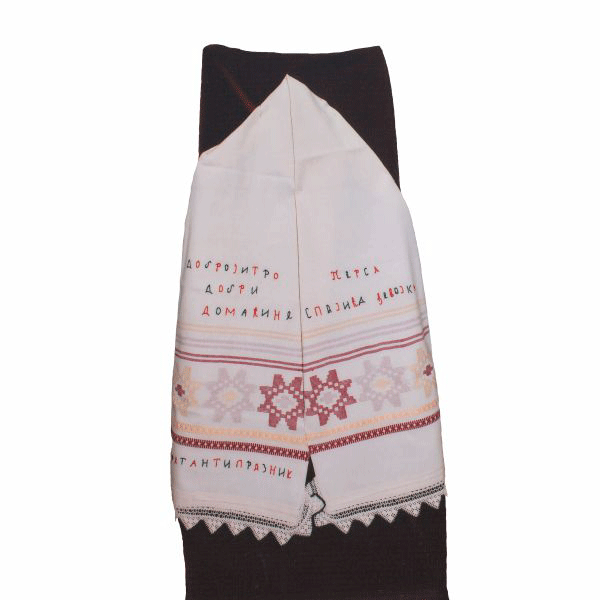Priča o Tekeriškom peškiru

Najteža je noć Cerske bitke, ona između 14. i 15. avgusta 1914. godine. Granate padaju na sve strane, svuda mrtvi i ranjeni. Vojnici Drugog prekobrojnog puka Kombinovane divizije junački se bore oko Tekeriša. Među njima i Mileta Milutinović iz Sedlara kod Svilanjca. Ranjen, geleri mu izranjavili obe noge. Saborcima ne da da mu pomognu, imaju važnija „posla“. Sam, uz mnogo napora, jedva je dopšuzao do kućeTihomira Stevanovića. Sreća zbog pomisli da će mu domaćini pomoći nestaje u trenu. Kuća prazna, čeljad izbegla. Da previje noge treba mu čista tkanina. Gde da je nađe? Da ne bi iskrvario, ipak otvara sanduk koji mu je tu, na dohvatu. A u njemu vezeni peškiri- devojačka sprema! Dilema velika, ali izbora nema. Mileta uzima dva peškira i previja rane…posle nekoliko meseci, oporavljen, vraća se u borbu, prolazi albansku golgotu, učestvuje u proboju Solunskog fronta, ali od tekeriških peškira se ne odvaja.
Po završetku rata Mileta se vratio u Sedlare, ali je sačuvao samo jedan peškir. Vreme prolazi, a savest zbog uzimanja peškira iz napuštene kuće, pa još iz devojačke spreme – ne da mira! Raspitivao se, zato, godinama o Stevanovićima i Spajićima iz Tekeriša. Saznao je i da je Persa tokom rata, pre udaje, umrla od tuberkuloze, ali savest srpskog vojnika nalaže mu da sačuvani peškir vrati.
To je i učinio kada je sa unukom došao na obeležavanje šest decenija Cerske bitke. Peškir je poklonio Muzeju „Cerska bitka“ na Tekerišu, ono su ga predali mesnoj kancelariji, odakle je septembra 1975. godine, dospeo u Narodni muzej Šabac.
Vernu repliku ovog peškira izrađuje Tkačka radionica „Stari zanati“ u okviru Gradske organizacije invalida rada Šabac. Ovaj proizvod zaštićen je geografskom oznakom imena porekla.

The Batle of Cer, the hardest night, August 14- 15,1914. Grenades being thrown ail over, dead and wounded all around. The soldiers of the Second overarching regiment of the combined division are bravely combating in the village of Tekerish. Amongstthem is Mileta Milutinovicfromthevillage of Sedlar nearSvilajnac. Both his legs are wounded. He doesn’t let his combats help him as they have more important „issues“. All alone, with enormous effort, he somehow crawls to the house of Tihomir Stevanovic. The feeling of relief at the thought that someone would help him disappears immediately. The house is empty, abandoned. He needs a clean cloth to bandage his wounds. Where can he find it? Intending to find something to prevent bleeding out, he opens a trunk within his reach. There he finds embroidered towels – a trousseau. He hesitates, but has no choice. Mileta takes two towels to bandage the wounds. A few months later, recovered, he returns to the battle, crosses the Albania’s Golgotha, participates in the Salonika Front, but never parts from the Tekerish towels.
After the war Mileta returns to Sedlar, with the one towel that remained. The time passed, but his consciousness still troubles him for taking the towels from an abandoned house, end even more for being a trousseau. For years he investigated about the Stevanović and Spajić families from Tekeriš and found out that Persa died of tuberculosis during the war, before marriage. But, the consciousness of a Serbian soldier makes him wantto returnthe remainingtowel.
He finally succeeds. Participating, with his granddaughter, in the 60th anniversary of The Battle of Cer, he presented it to The Battle of Cer Museum of Tekerish. It remained in the local office till 1975 when it was relocated to the Šabac National Museum.
